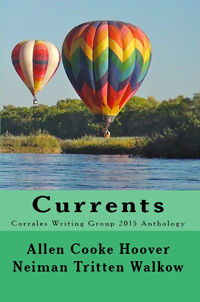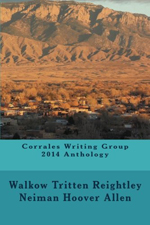Corrales Writing Group formed in 2012 and meets twice a month in the village of Corrales, New Mexico to review members’ writing and plan projects. This closed group is currently made up of authors Chris Allen, John Atkins, Maureen Cooke, Sandi Hoover, Thomas Neiman, Jim Tritten, and Patricia Walkow. Together they produce an annual anthology that includes essays, short fiction, memoir, and poetry. Their newest book, Love, Sweet to Spicy, was published in 2018. Follow Corrales Writing Group on Facebook and read part two of their 2016 interview for their take on group structure and indie publishing.
 Why did the group pick the theme of love for the 2018 anthology?
Why did the group pick the theme of love for the 2018 anthology?
Since the group formed, its members have written stories about love from time to time. It wasn’t necessarily about romantic love. Some stories were about parental love, love for a pet, and then, of course, romantic love. We had enough content to create an anthology on the theme, but we also wrote new stories, a few of which were collaborative efforts.
Five of the twenty pieces in the book are collaborations. What was the easiest part of collaborating for Love, Sweet to Spicy, and what was the most challenging?
The most challenging part of writing a collaborative piece was the need to leave our egos in a parking garage on Mars and work toward the common goal of creating a viable story. Imagine a blank canvas and asking three artists to create a visual work. Just like visual artists, writers have different styles. The commitment the writers make must be to the story itself, and not to their own opinions, methods, or styles.
Specifically, our group experimented with ways to get past the ego issue and settled on a method that worked for us. Each person in the group came up with a brief concept of a story with enough detail and character description to serve as a workable writing prompt. We then broke into teams of two or three members, but the individual whose idea it was did not participate in writing that particular story. Getting everyone to agree to this approach was probably more difficult than the actual writing. Once everyone tried it the first time, the method worked fine and all the finished stories were accepted for publication in anthologies or journals not associated with the Corrales Writing Group. Most won prizes in the annual New Mexico Press Women Communications Contest.
The easiest part of collaborating was the synergy and brainstorming that occurred when we created something together. Also, assignment of who did what was never an issue. Everyone did their fair share of work. Another enjoyable part was pairing male and female writing teams to ensure characters stayed true to their gender. This often led to interesting conversations that generally included something like, “Well my husband would never say that, or never do that,” followed by validation from group members of the opposite sex. We had a lot of fun kicking those situations around.
We initially designed our collaborative stories with more romance and just a hint of sex. Later, we experimented with more sexuality than romance. In the end, we found a balance between romance and sex in the stories based on suggestions from our beta readers.
Pick a piece from the anthology written by another member and tell us what you enjoyed most about the writing or the story.
CHRIS ALLEN: I loved the piece “The Anniversary Letter” by Pat Walkow. It describes a husband-wife connection in a wonderfully amusing way. It is made all the funnier knowing it is a memoir. Pat perfectly captures the dialogue of a couple after years of marriage.
JOHN ATKINS: “Last Days – A Dog’s Perspective” by Chris Allen recounts the final days of a beloved pet’s life. I’m drawn to stories about a person’s love for a pet. I particularly like Chris Allen’s approach. She gives the reader a unique look at a dog’s end of life routine as seen through the body and mind of the pet. Her writing tells a story all too familiar to many people, but from a point of view that makes it all the more moving.
MAUREEN COOKE: I particularly enjoyed Tom Neiman’s “A Heart’s Journey.” He writes eloquently about the love for his wife Gretchen and his concern when Gretchen underwent heart surgery. What makes this piece stand out is that Tom and Gretchen married in their later years, or as Tom writes, “…this wasn’t our first rodeo.” I enjoy reading about a real, as opposed to a Hollywood, love story. Tom’s devotion to Gretchen and her healing from heart surgery jumps right off the page.
SANDI HOOVER: “The Power of a Smile” is a beautiful homage to a loved one. Jim Tritten’s trick of not revealing—until the end—the person being written about is so artfully done that the reader floats along on the river of words, simply enjoying the emotions, the love felt for the object of the story.
TOM NEIMAN: “Enough to Kill,” written by Sandi Hoover and Jim Tritten, was developed from my original idea and they took it from there. When I read the first draft, it was as if my baby had grown into adulthood. I was so proud of how the authors stuck with my premise and developed it into their own.
JIM TRITTEN: I am not one who reads, writes, or normally critiques poetry. “What Love Is” by Sandi Hoover challenged me to understand, appreciate, and attempt to comment on an unfamiliar genre. I remember reading this piece for the first time. Here is what I sent the author: “My first thought was that the recipient of such feelings is a very lucky person.”
PAT WALKOW: I particularly liked two stories. “I Remember Hoover” is John Atkins’ story about love for a dog named Hoover. I found the dialog realistic, the emotion real, and the pace perfect. “End of the Story” is Maureen Cooke’s accounting of the end of a once-loving relationship. It is beautifully written and heart-wrenching.
 Since the last interview in 2016, Corrales Writing Group published Passages as well as Love, Sweet to Spicy. What’s new with the group? Any lessons learned from the publishing side?
Since the last interview in 2016, Corrales Writing Group published Passages as well as Love, Sweet to Spicy. What’s new with the group? Any lessons learned from the publishing side?
We’ve grown from six to seven members. In addition to individual work published in various print and online anthologies, members of the group have two major projects going. A group of four writers is working on a murder/mystery/romance novel, and a pair is working on an adventure novella. The writing will be reviewed within the group just as other pieces have been reviewed in the past: a series of questions will be answered by reviewers, changes will then be made by the writers, and the piece will be reviewed again. And possibly yet again!
We’ve learned a few key things:
1. It is best to have one person take the lead on being the editor of a specific anthology, with a secondary editor. Of the seven members of the group, five have now edited an anthology and become familiar with CreateSpace and Kindle Direct Publishing.
2. Read, reread, and reread before you publish. Then give it to others to read, reread, and do it again. No matter how many eyes have looked at the book, some silly flaw will escape until it is purchased, and then it blinks in neon. Fortunately, with independent self-publishing it is easy to fix.
3. Marketing consumes an awful lot of time, and we need to step up our efforts. We are actively engaged in finding places to present our work as performance pieces. A presence on Amazon, Facebook, Hometown Reads, and other social media outlets is necessary, and we share our work there. Our website is in progress.
The constant delight is still the fun we have, as well as the intelligence and humor of the members of the group. We have formed close bonds.
Six of the seven members of the group were featured in part two of the previous interview. Tell us about John Atkins, the newest member.
He’s retired, having spent more than 40 years in project and technology management in healthcare, hardware/software, and energy companies. He graduated summa cum laude from the University of New Mexico with a degree in Communication. His work has appeared in Love, Sweet to Spicy, as well as The Esthetic Apostle and 50-Word Stories. He’s well into the second draft of a speculative fiction novel and continues to serve as transcriptionist to worlds and characters that demand attention. None will leave until they have been written, rewritten, and polished until the turds they once were shine like the jewels they demand to be.
Give us a summary of your group’s accomplishments since forming six years ago.
The Corrales Writing Group (CWG) as a whole has published five different books. Two of our anthologies were produced both in black and white and color versions and all are available as Kindle books. Four members who wrote collaborative short stories had six chapters picked up and published elsewhere in other books. Six members had six chapters from our anthologies published as short stories in journals. Four of our individual members had six chapters published in other anthologies and thirty-seven of their CWG chapters published as short stories in other journals. The group’s books have won six awards, two additional awards for editing, and were finalists in two other competitions. Chapters or short stories based upon CWG chapters have won eighteen individual awards.
Is there anything else you’d like readers to know?
As part of the Corrales Writing Group, our members have written more than 100 pieces of humor, fiction, memoir, essay, and poems. We also reprinted Passages and Love, Sweet to Spicy in color to honor local artists who contributed photographs of their work to our anthologies. Individual authors have additional articles published in magazines, newspapers and journals.
Also, every Tuesday a few members have lunch at Las Ristras Restaurant in Corrales from 11 am to 1 pm on Taco Tuesday. It’s a meet-and-greet with other authors…sort of a round table discussion. Send a message to John if you’d like to drop by and chat.
 KL Wagoner (writing as Cate Macabe) is the author of This New Mountain: a memoir of AJ Jackson, private investigator, repossessor, and grandmother. Kathy has a new speculative fiction blog at klwagoner.com and writes about memoir at ThisNewMountain.com.
KL Wagoner (writing as Cate Macabe) is the author of This New Mountain: a memoir of AJ Jackson, private investigator, repossessor, and grandmother. Kathy has a new speculative fiction blog at klwagoner.com and writes about memoir at ThisNewMountain.com.




